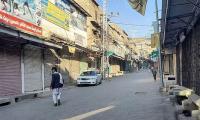During Taliban's previous rule in Afghanistan, the drug menace went away but when they were ousted, it came right back despite the presence of coalition forces. Now we have to wait and see how long it's going to stay in hibernation.
The sight of drug addicts begging for a few rupees or trying to steal manhole covers just to feed their habit breaks my heart. In our cities so many drug addicts die due to electrocution while trying to steal copper wires. It is a very sorry situation and demands stringent and pragmatic actions.
Narcotics is not a new phenomenon. Its history goes back centuries in the crude form of opium, belladonna, reserpine, senna, and ephedrine. However, in medicine, the first modern pharmaceutical use was by Friedrich Serturner (1804), a German researcher who separated the chemical from opium and named it after the Greek god of sleep. Since then, its production has been somewhat legalised.
The figures are appalling: The most frequent substance use disorder (SUD) caused 307,400 deaths in 2015, including 137,500 deaths related to alcohol, 122,100 deaths related to opioid abuse, and 12,200 drug-related deaths related to amphetamine and 11,100 deaths from cocaine.
A World Drug Report (2021) reveals that nearly 200 million people consumed cannabis in 2019, representing 4 percent of the global population, and opioid users grew by 62 million. There are nearly 20 million cocaine users worldwide, which means that 0.4 percent of the global population uses the drug, destroying lives, splitting up families, and affecting communities to an unimaginable degree.
Addiction's extreme intoxicating effects may drive even a good person to take their own life and commit felonious offenses. Unfortunately, the world over drug legislation hasn't prevented organised criminal drug cartels from being responsible for 25 percent of all illegal drugs with a net value of billions of dollars in their heydays. Despite Colombia's dominance in cocaine production, Afghanistan accounts for about 90 percent of world opiates production, posing a serious challenge for law enforcement. The new phenomenon of influx of synthetic drugs from Western countries, such as amphetamines and stimulants, is yet another alarming threat.
Prevention, early intervention, integrating treatment, and supporting recovery, as well as breaking the cycle of drug use, crime, and incarceration, are effective strategies. A valuable contribution of UNODC, USA's Bureau of International Narcotics and Law Enforcement Affairs, European Union, and the UK's National Crime Agency to build the capacity of law enforcement agencies across the country had been phenomenal in combating the narcotics perils.
Years ago, as I joined the police force, gradually taking on many of these mafias with relative success or surprising piece of luck, it wasn't long before I realised it was highly organised transnational crime, which funded many stakeholders, manipulating lives in the process at the expense of others for their worldly advancement.
A new trend in law enforcement is for physicians to be held responsible if they prescribe controlled substances without full patient control. Additionally, doctors are educating themselves about the potential for prescription drug abuse. As by prescribing sedatives or stimulants that can alter moods or cause intoxication without recognising the dangers of overdose of such drugs, people have ended up in tragic health situations.
We need a mechanism to enroll drug users confidentially and guard against stigmatisation, but we also need to register and regulate addiction treatment centers to ensure the availability of standardised evidence-based recovery support services that are delivered by competent staff.
The Colombo Plan discloses the presence of 135 treatment centers of which 31 percent are in Punjab, 7 percent in Balochistan, 21 percent in Islamabad, 20 percent in Gilgit-Baltistan, 19 percent in Khyber Pakhtunkhwa and Sindh, and few in AJK, with an annual capacity of around 32000. Active 10 percent are public hospitals, 47 percent are private clinics and 39 percent are run by NGOs or unregistered charities, where 45 percent of heroin addicts, 31 percent of cannabis/hashish users and 33 percent of crystal meth users were recently treated.
There is no doubt that worldwide drug control debates, despite universal government policies to control drug supply and curb abuse, have largely failed as SUD has reached an all-time high, with most resources spent on interdiction and law enforcement instead of public health.
The fact that we have 6.7 million drug users (2013) and that only 1 percent of all drug patients have access to treatment in our country – while in surrounding countries about 15 percent have access to treatment – is alarming. In countries with active heroin assisted programmes, the reduction of deaths due to drug-related causes has been significant, especially in children and adolescents. Cognitive behavioral therapy and family psychotherapy has greatly reduced SUD.
Further, what is needed internally and externally is to share actionable intelligence, prioritising drug demand reduction, recognised interventions, and recovery programmes to systematically interfere with the drug market. It is critical to curtail drug production and trade. To counteract the genetic and psychosocial factors that cause SUD in around 60 percent of users, training, credentialing, and certification for therapists is very important.
We need to acknowledge that, despite living in proximity to the world's largest poppy growing regions, our law-enforcement agencies have successfully responded to the challenge through seizures, arrests, prosecutions, public awareness, rehabilitation of drug patients, and precursor control. Through legislation and enactment of pragmatic laws, the state has earned the status of a poppy-free state since 2001. However, the growing trends of drugs in educational institutes require parents, teachers, civil society and all stakeholders to ponder ways and means to eliminate the root causes.
The obsession with addiction destroys an entire family, including anyone who tries to help. It is high time we realised that tomorrow may not come, or a second chance may not be available. Our generations' future depends on what we do today.
For drug addicts my sincere advice is, “Though no one can go back and make a brand-new start, anyone can start now and make a brand-new ending” (Carl Bard)
The writer is federal secretary at the Ministry of Narcotics Control. He tweets @KaleemImam and can be reached at skimam98@hotmail.com Facebook: @syedkaleemimam
Most recently, US presidential elections demonstrated how AI has amplified partisan split
Few years ago, Pakistan ranked as fourth-largest freelancer market globally, with potential to become number one
Arts Council Karachi celebrated its 70th birth anniversary at inaugural session with big cake
There are over 11 million Pakistanis settled abroad, out of which around six million work in Gulf and Middle East
This year alone, US Treasury would have to roll-over $10 to $14 trillion in maturing short-term debt
Tear gas no longer marks just protest sites; it paints entire cities as battlegrounds but then again, PTI did it first







